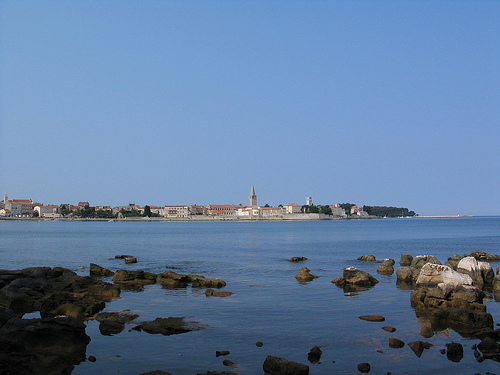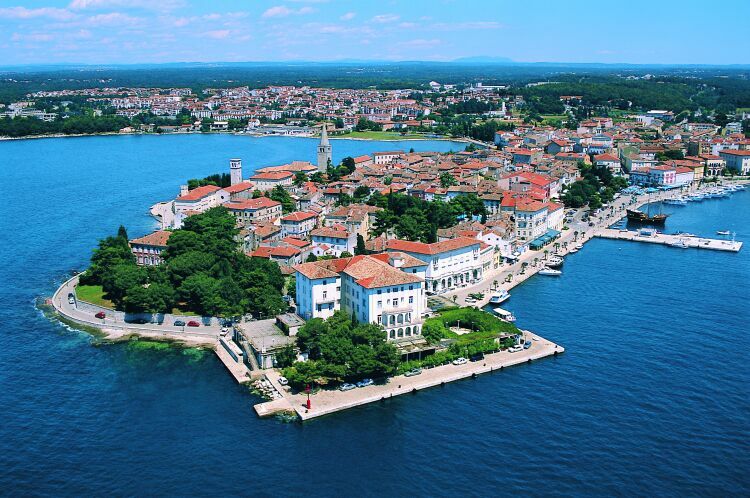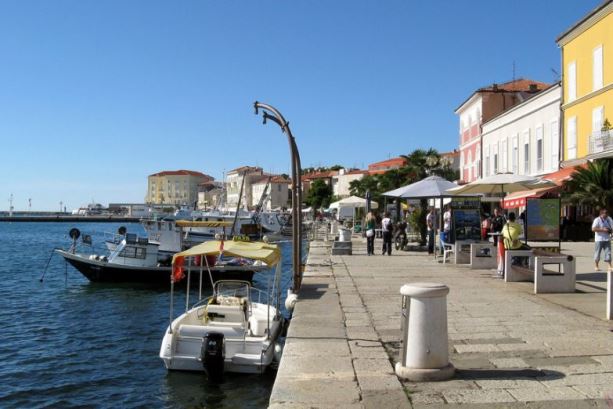

Location: Istria County Map
The city of Parenzo or Poreč (in Croatian: Grad Poreč, in Italian Città di Parenzo, in Latin, Parens or Parentium, archaic German: Parenz, Ancient Greek: Pàrenthos, Παρενθος) is a city and municipality on the west coast of the Istrian peninsula, in the county of Istria (Croatia). Porec is a small charming ancient city on the shores of the Adriatic Sea. It was found over 2000 years ago many of the streets in the city still keep original orientation of the narrow ancient Roman roads then the city was called by its Latin name of Castrum. The main site of Porec is its Basilica of Saint Euphrasius that was declared an UNESCO World Heritage Site in 1997.
Its mayor is Edi Štifanić, from the Democratic Assembly of Istria (IDS). It has an area of 139 km2, with a coastline of 37 kilometers long that goes from the river Mirna near Novigrad to Funtana and Vrsar in the south. Its population (in 2001) is 17,460 inhabitants, who live mostly in the outskirts. The population density is 126 inhabitants per km2. Its main monument is the Euphrasian Basilica, from the 6th century, a place declared a World Heritage Site since 1997. Poreč-Parenzo is almost 2,000 years old and spreads around a bay protected from the sea by the small island of San Nicolás (Sveti Nikola).
Poreč is located on the western coast of Istria and cooled by sea breezes, the local climate is relatively mild and free from the oppressive heat of summer. The month of July is the warmest, with a maximum air temperature of 30 ° C in conditions of low humidity, while January is the coldest with an average temperature of 6 ° C. There are more than 2,400 hours of sunshine per year, an average of more than 10 hours of sunshine during summer days. Sea temperatures can reach 28 ° C, higher than would be expected compared to the coast of southern Croatia while air temperatures are higher. The annual rainfall of 920 mm is more or less distributed regularly throughout the year, although July and August are very dry. The winds here are Bora, bringing the cold and clear weather of the north in the summer, and the warm sirocco of the Mediterranean from the south that brings the rain. The summer breeze that blows from the land to the sea is called the maestral.
In 1844 the Austrian naval company Lloyd opened a tourist line that serves in Porec-Parenzo. The first tourist guide that is described and represented in the city was printed already in 1845. The oldest hotel is the Cote d'Azur, built in 1910. Later came the Porestina and others. Nowadays, the tourist infrastructure is dispersed along the 37 km (23 miles) of coastline, between the Mirna River and the deep Lim Valley. The south houses autonomous centers such as Laguna Plava (Laguna Azul), Laguna Zelena (Laguna Verde), Tivat Uvala (Cala Blanca) and Brulo. To the north, the centers of interest are Materada, Červar, Porat, Ulika and Lanterna. In high season, the area has a temporary population that exceeds 120,000 inhabitants. The heritage of Parenzo can be seen in the historic center of the city, in the museums and galleries housed in the houses and palaces, many of them even private homes. In the off-season, weekend visitors from Croatia, Slovenia, Austria and Italy visit the area. Sports complexes are developed and used throughout the year.


Embankment of Porec at the Adriatic Sea is one of the most beautiful and picturesque places in a city. Porec Embankment is long enough for morning runs as well as lengthily walks during hours of sunset that are amazing. Historically this part of the town was home to numerous fishermen, traders and sailors. So naturally it was a bad side of town. However in the 19th century all that changed as city government decided to transfer these lands to public service. Wooden shacks and huts were torn down while wide Embankment was built. Additionally new large buildings were constructed facing the Adriatic Sea. Embankment of Porec is the most popular area among local residents as well as international tourists. You can rent a local boat for a short trip around the city. Additionally you can buy fresh fish from the local fishermen in the morning.
Poreč has been inhabited since prehistoric times.
During the 2nd century BC, a Roman castrum was erected on a tiny
peninsula, which was 400 m long and 200 m wide, and on which today
stands the core of the old city. During the reign of Emperor
Augustus in the 1st century, the castrum was officially declared a
city and included in the Roman colony of Colonia Iulia Parentium. In
the time of Rome, Poreč got its first walls, the whole city was
walled except for the west side or the top of the peninsula where
the temple of Neptune or Jupiter was located. In the 3rd century the
city already had an organized Christian community and an early
Christian church complex. The Christian community almost completely
disappeared in the time of Emperor Diocletian, when the martyrs of
St. Mauro and St. Eleutherium. Sv. According to tradition,
Eleutherius was tied to a stone and thrown into the sea in the bay
of Peškera. Today, right next to the bay is the church of Sv.
Eleutheriums from the 15th century
When the Roman Empire fell
in 476, the city fell under various rulers and powers. It was first
held by the Ostrogoths, and after 539 Byzantium ruled. During the
Byzantine rule, Bishop Euphrasius enthroned the city and had the
then double basilica restored. The new basilica was built on the
model of the basilicas in Ravenna with golden mosaics in the center
of which is the Virgin Mary with the little Christ in her lap. In
the apse to the left of the Mother of God are depicted Bishop
Euphrasius (wearing a model of a basilica), St. Mauro and Sv.
Eleutherium. In 599, in a letter to Pope John VI. for the first time
in the area of Istria, Slavs are mentioned who invade Istria and
plunder. Soon looting replaced permanent settlement and the first
permanent settlement was dated around 620 AD. By the Peace of Aachen
in 812 between the Frankish and Byzantine Empires, Istria officially
became part of the Frankish Empire, although this had happened for
788 years. An event known as the Rižana Placit should be singled out
from the period of Frankish rule, it outlines the conflict between
Istrian towns and the new governor of Istria, Duke Ioanes, ie the
towns complain about the usurpation of land inhabited by the Duke.
The conflict was resolved by compromise, Duke Ivan was accepted as
the lord of Istria, but he had to remove the Slavic settlers from
the city plots.
With the disintegration of the Frankish Empire,
independent communes were formed in Istria, including Poreč. It
would retain the status of an independent city until 1267, when
Poreč was placed under the protection of Venice, becoming the first
possession of the Republic of Sv. Mark in Istria. With the loss of
independence, the city fell into a slow decadence, especially after
1354, when during the Third War between Venice and Genoa, Genoese
Admiral Paganino Doria plundered the city and took away the relics
of the martyrs of Poreč (they will not be returned until 1938). In
1410, the city was besieged by the Croatian-Hungarian king Sigismund
(Sigismund) of Luxembourg, but failed to capture it. In the 14th and
15th centuries, Poreč was a city of merchants and craftsmen, and
then some of its most beautiful palaces were built, the Zuccato
Palace, the Parisi-Gonan Palace and others. Throughout the 16th
century, it was affected by numerous wars in which the Venetian
Republic participated, and then epidemics of various diseases,
primarily plague, and the population was constantly declining, so
that in 1630 the city had only about 30 inhabitants. Recovery began
in 1667 when the city was inhabited by refugees from Crete.
In 1797 Napoleon occupied Venice and abolished the Venetian
Republic, Poreč came under Austrian rule, and then in 1806 as part
of the Illyrian provinces it became part of Napoleon's Empire, after
the fall of Napoleon Poreč again became part of Austria as part of
the Margraviate of Istria. From 1861, with the imperial patent,
Istria gained its self-government and Poreč became the seat of the
provincial parliament: the Istrian Parliament (Dietà istriana). The
sessions were held in the former Franciscan church. During the 19th
century, Poreč became the scene of national ideologies, Italian on
the one hand and Croatian on the other. At the same time, the city
as well as the whole of Istria is experiencing modernization and
economic development, so at the beginning of the 20th century the
railway line Poreč - Trieste, better known as Parenzana, was
established, and the first hotels were built due to tourism.
After the First World War, Austria fell into disrepair and the city
came under Italian rule. During the 20 years of administration, the
city is in economic decline, primarily tourism, then the Parenzana
railway line was abolished. During the Second World War, the city
was bombed several times and the city center was severely damaged,
the Franciscan monastery and several "insulas" of the Strograd core
were destroyed. In 1947, with the Paris Peace Conference, Istria,
and with it Poreč, became part of Yugoslavia, and the city itself
left between 80% and 90% of its population and went into exile in
Italy. The Yugoslav period is characterized by industrialization
("Školjka" fish processing factory) and the construction of tourist
facilities.
In 1991, there was a change at the state level
when Croatia declared independence from Yugoslavia and Poreč entered
the 21st century as part of Croatia.
Poreč is located at 45.2258 degrees north latitude
and 13.593 degrees east longitude. It lies at an altitude of 29
meters.
The city, which is almost two thousand years old, is
located in the port, which is protected from the sea by the island
of Sveti Nikola. According to the 2011 census, the city itself has
9,790 inhabitants, most of whom live in the suburbs. The city of
Poreč as a whole has a total population of 16,696 according to the
same census from 2011.
The city of Porec has three islands and /
or islets that are classified in the category MPNNo (small,
occasionally inhabited and uninhabited islands and islets): Altijež,
Regata, Sveti Nikola and six smaller altitudes (rocks of different
shapes and sizes): Barbaran, Butaceja , Karbula, Safarel, Žontuja
and Žontujić.
The Poreč region or Poreč region covers 142
km², with a coast 37 km long, from the river Mirna near Novigrad in
the north to Funtana and Vrsar in the south. Apart from the city of
Poreč itself, the municipalities of Funtana, Kaštelir-Labinci, Sveti
Lovreč, Tar-Vabriga, Višnjan, Vrsar and Vižinada belong to Poreč.
The climate is very mild, without summer heat. August is the
warmest month with an average of 30 ° C and low humidity, and
January the coldest, with an average of 5 ° C. The city has more
than 3850 hours of sunshine a year, which is an average of more than
10 hours of sunshine on a summer day. The sea temperature can rise
up to 28 ° C, which is higher than the temperatures in southern
Croatia. The average annual rainfall of 920 mm is evenly distributed
throughout the year. In Poreč, the bora blows from the north and in
winter brings cold and sunny weather, the south, the warm wind that
brings rain from the south, and the mistral, the summer breeze that
blows from the sea to the mainland.
Nearby is the Baredine
Cave, the only open geological monument in Istria. The Lim Channel
is a sea bay like a fjord that enters the interior 12 km, and was
created due to the action of the river Pazinčica. It sometimes
contains boulders of quartz that expose the action of the sea.
The landscape has rich Mediterranean vegetation, with pine
forests and green macchia. The soil is made up of fertile red earth,
red soil, along with stones. Crljenica is good for agriculture
(cereals, orchards, olive groves, vegetable gardens). Today, the
production of organic food, olives, grapes, quality wines such as
Malvasia, Borgonja, Merlot, Pinot and Teran, is an important part of
Poreč's economy.